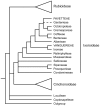Endophytic bacteria in toxic South African plants: identification, phylogeny and possible involvement in gousiekte
- PMID: 21541284
- PMCID: PMC3082559
- DOI: 10.1371/journal.pone.0019265
Endophytic bacteria in toxic South African plants: identification, phylogeny and possible involvement in gousiekte
Erratum in
- PLoS One. 2011;6(6). doi: 10.1371/annotation/e7fa3cdf-c7bc-439f-83a2-36da63ef6c08
Abstract
Background: South African plant species of the genera Fadogia, Pavetta and Vangueria (all belonging to Rubiaceae) are known to cause gousiekte (literally 'quick disease'), a fatal cardiotoxicosis of ruminants characterised by acute heart failure four to eight weeks after ingestion. Noteworthy is that all these plants harbour endophytes in their leaves: nodulating bacteria in specialized nodules in Pavetta and non-nodulating bacteria in the intercellular spaces between mesophyll cells in Fadogia and Vangueria.
Principal findings: Isolation and analyses of these endophytes reveal the presence of Burkholderia bacteria in all the plant species implicated in gousiekte. Although the nodulating and non-nodulating bacteria belong to the same genus, they are phylogenetically not closely related and even fall in different bacterial clades. Pavetta harborii and Pavetta schumanniana have their own specific endophyte--Candidatus Burkholderia harborii and Candidatus Burkholderia schumanniana--while the non-nodulating bacteria found in the other gousiekte-inducing plants show high similarity to Burkholderia caledonica. In this group, the bacteria are host specific at population level. Investigation of gousiekte-inducing plants from other African countries resulted in the discovery of the same endophytes. Several other plants of the genera Afrocanthium, Canthium, Keetia, Psydrax, Pygmaeothamnus and Pyrostria were tested and were found to lack bacterial endophytes.
Conclusions: The discovery and identification of Burkholderia bacteria in gousiekte-inducing plants open new perspectives and opportunities for research not only into the cause of this economically important disease, but also into the evolution and functional significance of bacterial endosymbiosis in Rubiaceae. Other South African Rubiaceae that grow in the same area as the gousiekte-inducing plants were found to lack bacterial endophytes which suggests a link between bacteria and gousiekte. The same bacteria are consistently found in gousiekte-inducing plants from different regions indicating that these plants will also be toxic to ruminants in other African countries.
Conflict of interest statement
Figures


References
-
- Prozesky L. PhD Thesis. University of Pretoria, Department of Paraclinical Sciences; 2008. A study of the pathology and pathogenesis of myocardial lesions in gousiekte, a cardiotoxicosis of ruminants. - PubMed
-
- Bode ML, Gates PJ, Gebretnsae SY, Vleggaar R. Structure elucidation and stereoselective total synthesis of pavettamine, the causal agent of gousiekte. Tetrahedron. 2010;66:2026–2036.
-
- Ellis CE, Naicker D, Basson KM, Botha CJ, Meintjes RA, et al. Damage to some contractile and cytoskeleton proteins of the sarcomere in rat neonatal cardiomyocytes after exposure to pavetamine. Toxicon. 2010a;55:1071–1079. - PubMed
-
- Ellis CE, Naicker D, Basson KM, Botha CJ, Meintjes RA, et al. A fluorescent investigation of subcellular damage in H9c2 cells caused by pavetamine, a novel polyamine. Toxicology in Vitro. 2010b;24:1258–1265. - PubMed
-
- Kellerman TS, Coetzer JAW, Naudé TW, Botha CJ. Cape Town: Oxford University Press; 2005. Plant poisonings and mycotoxicoses of livestock in southern Africa.215
Publication types
MeSH terms
LinkOut - more resources
Full Text Sources
Molecular Biology Databases

